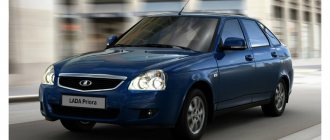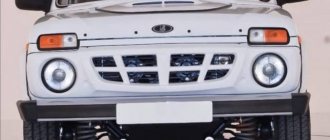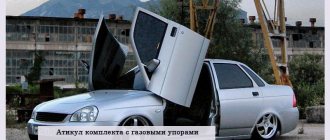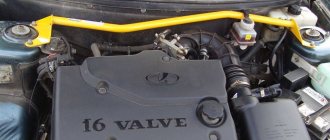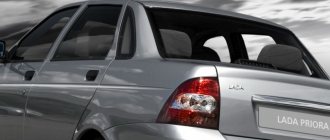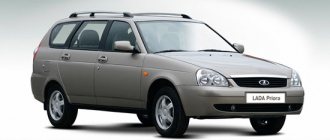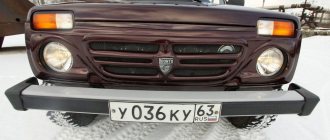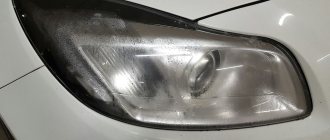The Lada Priora on the robot is loved by many car enthusiasts, because it is affordable to purchase and maintain, unpretentious, passable and playful. In 2013, when sales of the restyled Priora began, the AMT transmission, also known as the robot, on the Priora became a real novelty for the Russian automobile industry. Although the Priora with a robot gearbox is more expensive, its price starts from 26,000 rubles. But before that, there were no such cars on the VAZ, so people took the mechanics as usual. The robot box is a well-designed, modernized German box, with good foolproof protection!
Based on reviews from owners of Priora with AMT, other buyers also made a choice - the reviews were indeed very laudatory. For a car that was not taken seriously by those who love comfort, this was a very big step. Priora with AMT (robot) makes driving more comfortable and relaxed. Read the article to the end and you will know what kind of beast Priora is on the robot!
Factory AMT gearbox on Priora: price and article number
The new gearbox in VAZ was developed on the basis of an old frozen project. In 2009, the development of a manual transmission for golf-class cars was closed, but good performance led engineers to the idea that the VAZ-2116 gearbox, a new generation of manual transmission, could become a prototype for an automatic transmission.
A robotic automatic transmission with electric actuators from ZF is now used in front-wheel drive Ladas. The automatic transmission has code 2181 for Kalina and Granta, and the Priora has an automatic transmission with code 2182. A Lada Priora car with AMT at the dealer and on the secondary market costs about 20 thousand rubles more than a Priora with a “mechanics”. It works in four positions: R, N, A and manual gear shift (“+” is responsible for upshifting, “-” is responsible for downshifting).
At the cost of a small budget
The cost of the “robot” cost AvtoVAZ $20 million, which is relatively little. But even with such costs, the Tolyatti Automobile Plant will have to pay for its development for several years, provided there is adequate demand for the Lada Priora AMT. The electric actuators and brains in the new gearbox were developed by the German company ZF. Actually, most of the expenses were spent on its services, as well as on experimental tests at the Nurburgring. The good old mechanical VAZ-2180 is taken as the basis.
Lada Priora AMT
Maximum localization of production and ready-made developments have made it possible to significantly reduce the cost of the product. True, we also had to abandon some functions present in more expensive foreign “robots”. For example, there is no parking function: if you forget to put the handbrake on the car, it can simply roll far “beyond the horizon” along an incline. When the car is stationary, you must either manually hold the brake or keep the Priora on the handbrake.
But there is also an obvious advantage of our “robot” over sophisticated automatic transmissions. Due to the fact that in the disabled position on the Lada Priora the gearbox is constantly in the neutral position, it can be easily started from a pusher even with a dead battery. According to AvtoVAZ instructions, a speed of 7 km/h is enough, after which the AMT lever must be switched to mode “A” and the car should start.
Despite all the concerns associated with the fact that the clutch in the VAZ gearbox is single, the car moves quite smoothly. Of course, some jerks and dips in power when changing gears still occur, but they are obviously leveled out as much as possible. If you don’t rev the car at all or slow down sharply, the disadvantage is almost imperceptible.
Handling and dynamics
Of course, the Priora's mechanical racing abilities in city conditions are known. Up to 100 km/h Priora with a 98 hp engine. or 106 hp accelerates in 11.5 seconds according to the manufacturer. But when installing AMT, the acceleration time to 100 km/h increased by as much as 1.1 seconds. There are mixed reviews from Priora owners with AMT: some say that the “brain” shifts gears on time, others, on the contrary, scold the robot and say that gears do not change immediately.
Even when equipped with AMT there is no directional stability yet! However, you can go back to basics: just switch to manual control mode, and then you can downshift or upshift yourself. In normal mode, the automatic works with the transmission itself, but at speeds after 100 km/h it seems to stop and does not accelerate. It is still not clear whether this is the concern of the AvtoVAZ designers or a lack of the gearbox.
With full braking and a sharp driving style, the robot slows down - engages first gear, the speed increases, and engine braking begins. The automatic “freezes” and only after some simple manipulations it switches to second gear, and the car accelerates.
Test drive Grants with a robot: race results
According to the control principle, the new gearbox is not inferior to the simplicity of automation. The movement begins by pressing the brake and moving the selector to neutral. This system allows you to secure the start of the car, thereby preventing errors when working with the new product. Driving a robotic Granta will be more familiar to previous owners of cars with an automatic transmission.
The conducted races were able to show how easy the model is to control: it accurately responds to switching, but exhibits a slight delay when starting. Short signal transmission is not critical.
For many motorists, this feature will not be a problem to purchase. But before purchasing, you need an independent test drive to evaluate the ease of operation.
AMT box: pros and cons
An automatic manual transmission (AMT) handles the gear shifting itself, leaving the driver with the main task of keeping an eye on the road. Banal emergency braking using the service brake system is easier to do automatically - move your foot from the gas pedal to the brake pedal and press. On a manual, after pressing the brake pedal, you need to have time to move your left foot to the clutch pedal so that the car does not stall.
The advantage of a car with a “robot” is that when driving at high speed it is easier to drive – you don’t need to be distracted by controlling the gearshift lever. If you need to accelerate, having first downshifted, the gearshift lever is easily moved to the manual mode position in an instant, and then switched back to automatic mode.
An important point is that due to the fact that the box has become a symbiosis of a good project by AvtoVAZ and the ZF company, fuel consumption on a Priora with AMT has decreased compared to a Priora with a manual transmission.
“Robot” from AvtoVAZ: not “automatic” and not “mechanical”
AvtoVAZ organized a presentation and test drive of its new model in Belarus, where the company’s president, Bo Andersson, also flew in to talk with journalists. We will present material about the new product in an unusual format. We will not pay attention to the middle-aged car, about which a lot has already been said, but instead we will answer all your questions about the new “robot”.
Why does AvtoVAZ need a “robot” if it already has an “automatic”?
The main official reason voiced by AvtoVAZ is the low cost of the robotic transmission and good fuel efficiency compared to a hydromechanical automatic transmission. But why then did Granta and Priora receive the old Japanese Jatco automatic transmission, and not the wonderful progressive robot?
Because it was easier to buy a proven unit in Japan than to invent your own box. And everything would be fine if the design of the Priora allowed the installation of this same automatic transmission. AvtoVAZ doesn’t say what exactly is stopping them, but it didn’t work out to make Jatco and Priora friends. Should I purchase another unit from a third-party company that will suit Priora?
Expensive. What if you leave the car with its usual VAZ box and install a robotic “superstructure”? That's exactly what they did. Moreover, the main complaints from buyers about the box concerned the switching mechanism.
What engine does the VAZ “robot” work with?
It is logical that VAZ decided to “make friends” with the automated transmission with the top-end engine - a 16-valve 106-horsepower. In addition to this, we recall that in the Priora engine range there is a less powerful option that develops 98 hp.
Is the “robot” really AvtoVAZ’s own development?
Yes and no. The box itself, that is, a set of gears of different sizes, remained the same, from Tolyatti. But the VAZ team wisely decided not to design the control electronics themselves. It’s long, risky, and it’s not a fact that it’s cheaper. The Germans, the ZF company, were chosen as a partner. Without exaggeration, the best specialists in robotic transmissions in the world. It was they who developed the most advanced “robot” to date with two clutches, PDK, which is installed on Porsche.
1 / 4
2 / 4
3 / 4
4 / 4
What is the design of the “robot” on the Priora?
“Priora” is not a Porsche, and budget models do not rely on “robots” with two clutches. Our model received a robotic transmission with one clutch, like a regular manual transmission. We have already said above that Priora’s “robot” consists of a VAZ gearbox and a control system from ZF. The latter includes two actuators (that is, electric motors) for selecting gears and engaging/disengaging the clutch, a control unit for these motors, as well as a joystick selector with which the driver switches modes.
1 / 3
2 / 3
3 / 3
What modes are there on the Priora robot?
There are four modes. N is neutral, A is an analogue of “drive” on conventional automatic transmissions, R is reverse, and M, located to the left of neutral, is a manual mode for switching independently using the same joystick. Have you forgotten anything? Oh yes, where is P, that is, parking? And there is no parking. During short stops at traffic lights, you will have to switch to neutral and keep your foot on the brake, but in the parking lot you can safely turn off the car with mode A on. The gears will be engaged, and the car will not move anywhere - there is no need to lift the handbrake.
How does manual robot mode work?
Changing gears is easy. We push the joystick forward - switch “up”, pull it towards ourselves - “down”. It is important to understand that the automation is equipped with a “foolproof” system. It will not allow you to drive for a long time at maximum speed, and when the tachometer needle approaches the limit, the box will shift to a higher gear even in manual mode. The only exception is first gear. If you “spin” the motor on it, the “robot” will not shift up, but will simply open the clutch. Logic is not without its oddities. How to climb a high slope? Apparently, you will have to do this from acceleration and not “overclock” the engine.
How to drive off in a robot?
In fact, this is not an idle question. Robotic boxes are often difficult to control at the start. On the Priora, you need to move the selector to position A, then press the brake and only then press the gas. Why these difficulties? “Fool-proof” again, they say at AvtoVAZ. What if a child or dog accidentally switches the selector and then presses the accelerator? The need to press the brake between these manipulations eliminates the risk 100%. The system certainly takes some getting used to, but it is not without logic. The main thing to remember is that if you did not press the brake and started to press on the gas, you will have to switch back to neutral and again to mode A.
What's wrong with the "robot" on the Priora?
There are no obvious shortcomings that other similar “robots” would not have. Yes, the electronics depress the clutch and change gears slowly and not as smoothly as on a hydromechanical automatic transmission. But you will encounter the same problem on any other car with a classic “robot”. For example, on a Peugeot 301 or Citroen C3 Picasso.
What is good about the “robot” on the Priora?
The same thing that any “robot” is good for: cheapness and efficiency. And if the first advantage is more likely to benefit AvtoVAZ, then the second is important for every owner. In the combined cycle, the Priora with the robot will consume 5.6 liters per 100 km. For comparison: the same car with a manual transmission will require 6.8 liters, a Grant with an automatic transmission will require 7.6 liters, and a Kalina with an automatic transmission will require all 8 liters. This is all passport data, which in practice may turn out to be higher. But the proportions will not go away.
1 / 4
2 / 4
3 / 4
4 / 4
How much will a Priora with a “robot” cost?
Fortunately, the automated transmission will be available in both trim levels. “Priora” in the “Norma” version with “robot” will cost 428,000 rubles, and in the “Lux” configuration - 482,900. The increase in price is approximately the same as that of “Kalina” with “Grant”, if we compare mechanical and automatic versions .
Which AvtoVAZ models, besides the Priora, will this “robot” be installed on?
According to preliminary data, the robotic gearbox will be installed on all of AvtoVAZ’s own models, that is, on Granta, Kalina, and subsequently on Vesta. Lada Largus is built on the Logan base, and they definitely won’t install a “robot” on it. Datsun on-DO, made on the basis of Granta, is in question.
Will it completely replace the Jatco automatic?
AvtoVAZ has no definite plans in this regard. As Bo Andersson said, at first the Grants and Kalinas will be produced in both robotic and automatic versions. The final choice, apparently, is up to the buyer.
1 / 4
2 / 4
3 / 4
4 / 4
Malfunctions of the AMT box on the Lada Priora
Owners of Prior on AMT complain that when driving over speed bumps and on the highway, the robot shifts gears without permission. On the highway, he upshifts early, making it difficult to gain speed. But when passing speed bumps, when the driver “slows down” in order to drive over the obstacle more smoothly, the transmission engages first gear and does not want to shift further.
If we talk about the needs and requirements of a robotic gearbox, then what is most harmful to it is the habit of drivers who have switched to a manual transmission and have not yet had time to get used to it. When fully braking on “mechanics”, very often the lever is reset to the “Neutral” position in advance, although this is not recommended, because the brakes wear out even more. However, the manual transmission handles this switching quite calmly.
The automatic transmission will not withstand constant engagement of neutral gear at speed. At an intersection with a traffic light, you also do not need to turn on “Neutral”. The robot feels calm in position A and will not suffer at all from such treatment.
Very often, the clue to the cause of a gearbox malfunction is found by sound. A creaking or howling sound is far from normal clutch operation. You can diagnose AMT yourself, but it’s better to do it step by step:
- Turn on the ignition (Do not start the engine!). Press the brake pedal and alternately switch on different gearbox operating modes. It's worth listening to how smoothly the gears shift. The corresponding letter designations must be displayed on the instrument panel.
- Start the engine. If a howling sound is heard from below (in the area of the clutch housing), then either the clutch release bearing or one of the gearbox bearings is worn out;
- Once again, turn on the gears one by one and listen to the sounds again. If you hear a crackling or crunching sound, it is because the clutch is not disengaging completely. The first and most obvious is the loss of elasticity of the clutch diaphragm spring. If the crunching noise does not disappear, it is worth checking the electric clutch release drive. It is difficult to check it using fault codes in the transmission control unit.
- If you hear a squeaking noise in gear when the brake is pressed, the reason is in the clutch actuator.
- Continue testing. Shift into neutral and release the brake. The car should roll; don't wait for it to stop on its own. Engage reverse gear and try to start driving without pressing the accelerator pedal and with pressure. If the movement is smooth, then everything is fine with this transmission.
- Driving in third or fourth gear. If the speed increases sharply, but the car does not accelerate, the clutch slips.
When driving in automatic and manual modes, gears must be switched in a timely manner. Otherwise, a failure has occurred in the electronic transmission control unit. A service technician will deal with this problem. AMT was once the dream of all car enthusiasts in the countries of the former USSR, and in 2013 a new era began when they began installing a robotic gearbox on one of the most beloved models of the Volzhsky Automobile Plant. This is just the beginning, and in the future we can expect competitive automated transmissions on new domestically developed cars.
Automatic transmission from other cars
Despite the fact that the new Priora 2014 will already be equipped with an automatic transmission as standard, many owners continue to change the transmission on their own or through dealer services. The most popular option remains the installation of an automatic transmission from a Toyota Corolla on Priora. True, most cars are not equipped with a new transmission, but a used one. Some dealerships even have a special program, which means that the owner is given an automatic transmission from Toyota, and the original manual transmission is taken on consignment. He only pays the difference in price and rework.
To install an automatic transmission from another car under service conditions, it is often necessary to manufacture additional parts. For example, for the same automatic transmission from a Corolla, you need to make an internal CV joint. It is turned on a lathe. The work is very labor-intensive and requires excellent turner skills. After all, if you allow any play, the unit will quickly break down.
Today, by 2014, we have already learned how to carry out installation work professionally, so in most cases you don’t have to worry about the quality. However, if the parts are nevertheless manufactured incorrectly, and even if a mistake is made during installation, the owner may find himself in a rather difficult situation. For example, if there is a breakdown far from home, when there are no spare parts or technicians nearby, the car will have to be transported for many kilometers to the dealers by tow truck.
Instrument panel improved
At the same time, installing an automatic transmission from a Japanese foreign car on a Priora remains a very popular solution. Even if the automatic transmission has already been used, its resource will still last for a very long time. There is an opinion that even the new Jatco transmission does not last as long as the old Corolla transmission.
By the way, not so long ago one of the enterprises in Tolyatti released a trial Priora with a CVT. It is unknown from which car the variator was borrowed, but tests have shown that on the Priora it has many advantages over robotic and automatic transmissions. It is quite possible that after some time such cars will be assembled in small quantities at dealerships.
